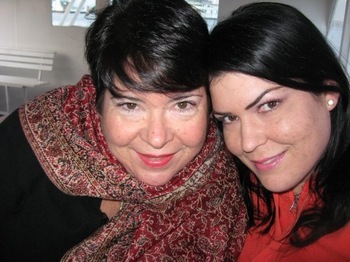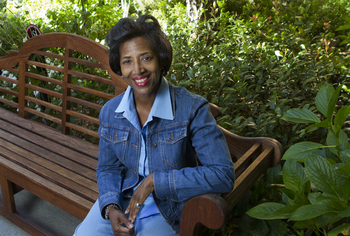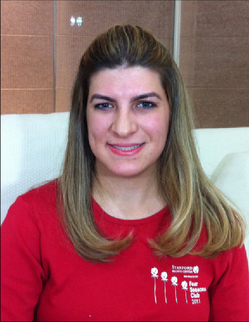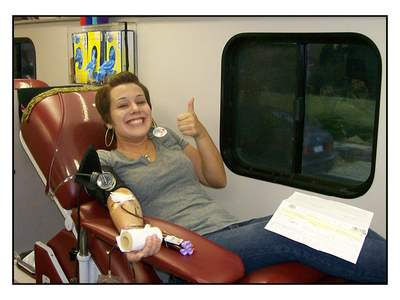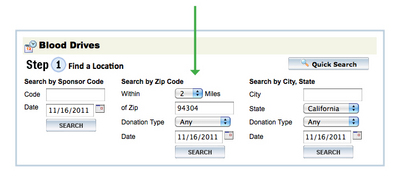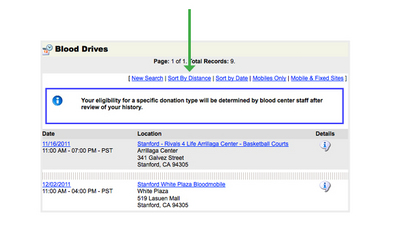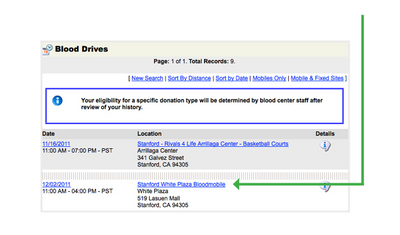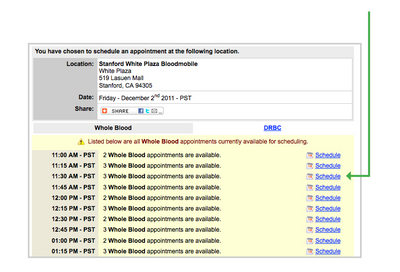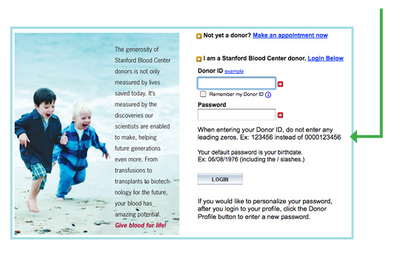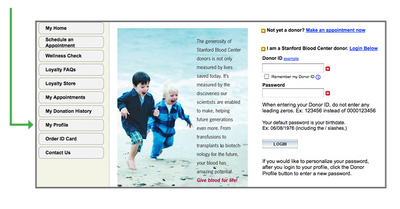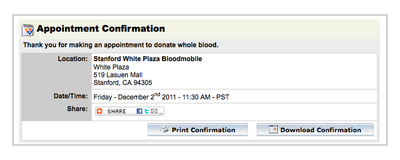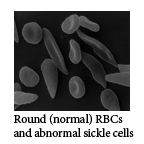November 2011
#WhyIGiveBlood: Because of My Dad
| Tweet |
Many of our donors have unique stories about why they started giving blood. Through our #WhyIGiveBlood campaign, we are taking the opportunity to highlight some of them as an inspiration for others. This first piece in the series is by Tami Turner, a long-time, dedicated SBC blood donor.
My father is the reason I'm a 300+ unit donor. I grew up in the hills above Peninsula Hospital, for which my father was an on-call whole blood donor. He had AB blood, and would be called sometimes in the middle of the night to go down and donate.
When he died prematurely in 1985, it occurred to me that we were losing a whole generation of donors from WWII & Korean War eras, and that I needed to step up to the plate!
So it began, my donations at Peninsula Blood Center (in front of the hospital), Irwin Memorial, Sacramento Medical Foundation (now BloodSource), Blood Bank of the Redwoods, and currently here at Stanford Blood Center where I have a date every other Tuesday with my friends on Welch Road. :)
You can imagine how happy and proud I was when my 15 year old daughter came to me inquiring if she too could donate. At 17, she began her donations journey in Santa Rosa and continues today in Sacramento.
I think as parents it isn't always what we say, as it is what we do, that influences our children the most. I miss my dad so much, but in this act, I feel connected to him, and that makes me happy.
If you would like to have your story featured with us, please click on the "E-mail us a story suggestion" link to the right. We would love to hear from you!
I’d Rather Be in the Bahamas
| Tweet |
By Michele Hyndman, Public Relations Manager, Stanford Blood Center
As Jennifer Flowers sat in a hospital bed on January 8, 2010, she would have much rather been on a beach on one of the tropical islands she preferred to frequent. Walking through the surf on a sandy beach in Hawaii, the Bahamas, Barbados, Antigua, Bermuda, or Jamaica during one of her vacations was her idea of living. But that day, she was receiving a bone marrow transplant at Stanford Hospital that would keep her alive.
The process started in October 2008 when Jennifer was diagnosed with multiple myeloma, a cancer of the plasma cells in bone marrow. “I had been experiencing tiredness and pain in my left pelvic area,” she explained. Jennifer had always been active and was one of those rare people who looked forward to going to the gym. “As a young, health-conscious, professional woman, who exercised four times a week, I was stunned by this diagnosis.”
That year, devastating news had already rocked Jennifer’s life. “My family and I endured the following battles: in the first trimester, my mother was diagnosed with non-Hodgkin’s lymphoma; in the second trimester, my father was diagnosed with metastatic colon cancer; in the third trimester, I was diagnosed with multiple myeloma,” she said.
“With the help of God and my family, I summoned all of my strength to fight," said Jennifer. She underwent chemotherapy causing her blood counts to drop. “They explained to me the importance of receiving a blood transfusion. That’s when I truly understood the meaning and purpose behind being a blood donor and how special it was to me that someone took the time to donate blood to save someone else’s life,” she said.
An autologous bone marrow transplant where her own stem cells were harvested resulted in an extended stay in the hospital and radiation treatments. Eighteen days after her release, while she was recuperating at her parents’ home, Jennifer’s father died.
Two of Jennifer’s sisters took "Family Leave" in order to nurse her back to health; her brother and other sister relieved them on the weekends. The prayers of friends, perseverance, time and determination aided in her yearlong recovery, she says. Now, "I'm living my life like it's golden."
Jennifer is now supporting the Light the Night Walk to raise funds for the Leukemia and Lymphoma Society to bring help and hope to people battling blood cancers. “I have a newfound appreciation for life and the example I set for others,” she said.
Jennifer hopes to plan a trip to Dominican Republic next year.
Jennifer is featured here in a short video, part of our "From the Heart" series:
Nine Lives: A Blood Donor’s Odyssey Donating Around the South Bay
| Tweet |
By John Williams, Marketing Manager, Stanford Blood Center
Lisa Sanfilippo has donated blood in nine separate locations in the past five years. Such is her passion for continuing to help save lives by finding a Stanford Blood Center (SBC) blood drive or Center location wherever she happens to be when eligible to donate.
Lisa donated her first unit at Saratoga High School in 2007 and was instantly hooked. She says, “I got my donor card in the mail and found out what my blood group is – it was cool.” Coming from a medical family – her grandfather was a pediatrician, grandmother a nurse, and father an endodontist – Lisa is passionate about giving blood as a way of helping others. After her first donation in high school, she was determined to continue donating, which she did, first at our Mountain View Center, then at the following mobile blood drives throughout the South Bay:
Emanuel Lutheran Church - Saratoga
Courtside Club – Los Gatos
Coldwell banker – Los Gatos
Intero Real Estate – Los Gatos
Hewlett Packard – Cupertino
Prospect High School – Saratoga
Congregation Shir Hadash - Los Gatos
Lisa found these blood drive locations by searching on our website. As we conduct many blood drives from South San Francisco to Gilroy, and some in the East Bay, it was easy to find a convenient location when she needed it. Most community drives are open drives, meaning that the general public can make an appointment or simply drop-in. Lisa experienced a wide range of donation sites, including gyms and cafeterias. Blood drives are also held at schools, malls, churches, or other community spaces. She says that her favorite place is the bloodmobile because of the high tech interior, with the screens and machines.
Lisa is now a student in the University of San Francisco Nursing Program. She says that she’s had the opportunity to discuss the nursing profession with SBC nurses: “They have all been so friendly and nice, and I’ve asked them how they got their start in nursing.” Despite her busy schedule, Lisa intends to continue donating. She recently received her Four Seasons T-shirt and she pledges to wear it every time she donates, wherever that may be, which makes her a fine example of the spirit of giving.
Tips & Tricks: Finding a Blood Drive Near You
| Tweet |
By Julie Ruel, Social Media Manager, Stanford Blood Center
Click here to view this information in an online tutorial.
Visiting a mobile blood drive is a convenient way for busy parents, students, and professionals to keep up with their routine of donating blood without having to travel too far. We come to you so you don’t have to come to us! Accounting for about 55% of the total amount of blood we collect, our drives are hosted at college campuses, high schools, churches, and hundreds of companies in the Valley and up the Peninsula.
Geographically, we cover quite a bit of land. You might spot our bloodmobiles traveling south on 101 to Gilroy, north on 280 to San Francisco, cruising along in downtown San Jose or even parked in a residential neighborhood. Searching for a blood drive in a location that’s convenient for you is easy! Just follow these steps.
1. Browse to https://sbcdonor.org.
2. Click on the advanced search link under “Make an Appointment at a Mobile Blood Drive”.
3. In the middle column, enter your desired zip code.
Note that the search radius is set to a default of 5 miles. You may want to change this to 2 miles to narrow in a bit closer. Leave the donation type as “Any” and the date as today (this will allow you to view all blood drives today, going forward). Click Search.
4. Click on the “Mobiles Only” link.
5. Depending on the zip code entered, you may have many results. To narrow in a bit closer to your desired location, click on the “Sort by Distance” link.
6. Find your preferred blood drive and click on the name.
7. Find your preferred time and click on the "Schedule" link to the right.
Here, you will be prompted to log on to your account. Click OK.
8. A. Enter your donor ID number. This can be found on your donor ID card.
If you don’t know your donor ID number, send an email to sbconlinehelp@lists.stanford.edu or call us at 650-736-7786. We’ll ask you to confirm your date of birth so we can be sure to provide you with the correct ID number.
**If this is your first donation with us, click on the link next to “Not yet a donor?” at the top of the page and follow the instructions.
B. Enter your password. Your default password is your birth date, entered as shown on the website, with slashes.
If you would like to personalize your password, after you log in to your account, click the My Profile button, scroll to the password field and enter a new one.
9. You should now see your appointment confirmation. You may print this page or add it to your online calendar.
Donating blood is an activity that many of our dedicated donors treat as an important part of their regular routine. Regardless of where you donate, we acknowledge and appreciate the time and effort involved with each visit.
Grateful Recipient
| Tweet |
By Dimone Gabler, recipient of blood products & champion of blood donors
I thought people who received blood either had surgery, a transfusion for a particular condition, or had been in a serious accident. I found out there are other reasons one might need blood. A few years ago, I thought I had a bad flu bug. After two to three days of not being able to keep anything down, my husband insisted I go to the doctor. I was so weak I was barely able to stand. After the doctor's examination, he sent me to the emergency room at Good Samaritan Hospital.
My then 7-year-old granddaughter was in the ER with her Grandpa and me during this entire process and the ER staff was absolutely wonderful. They explained everything they were doing to Grandma and assured her that all would be okay and I'd be as good as new in a few days. I'm most grateful that what could have been a very frightening experience for a young child turned into an interesting and educational adventure with Grandma because of the kindness and sensitivity of the ER doctors and nursing staff.
After the ER exam, it was determined I was bleeding internally and would need a blood transfusion. Once recuperated, I requested copies of my hospital report and upon review, found I had been admitted in critical condition and had lost over half my volume of blood. I'm a very lucky lady and most grateful for all those who have generously and courageously given blood to save someone’s life or help someone like myself get better.
You never know if a family member, good friend, or even you yourself may need blood. I’m grateful it was there when I needed it and I hope more people will make the time to donate blood.
Laughter, It’s Good for the Heart
| Tweet |
By Julie Ruel, Social Media Manager, Stanford Blood Center
Being happy in life is a goal that many people across the globe have in common. So how is it then that we achieve happiness? Over the last decade or so, this has become a hot topic. Psychologists have plunged into the science of what brings people happiness and how to make it sustainable.
HopeLab, a non-profit dedicated to improving the quality of life for young people with chronic illness, has been experimenting with this subject through the JOY Campaign. Their mission with this project is to create and capture moments of joy and share them with the world. And capturing these moments is exactly what happens when they turn up in various locations with their photo booth in tow. Let’s face it, who doesn’t like to pull that curtain closed and be ridiculous in front of a camera that doesn’t judge?
Last week on Halloween we had the treat of getting our blood donors involved when HopeLab set up shop at our Mountain View Center. It’s been said that expressing gratitude and practicing acts of kindness are excellent ways to give your happiness level a boost. So perhaps these people were already a step ahead as they arrived ready to give a pint of blood - a beautiful example of expressing kindness toward others. But what we saw were grown adults leaving their inhibitions behind and stepping into the booth. And what followed were four flashes and laughter so genuine and uninhibited, I think these folks may have even surprised themselves!
It’s these moments of spontaneous silliness that keep us young at heart. Let’s work on making these happy moments lasting moments. Think about what you’re grateful for. Show compassion for someone who needs it. Maybe you’re already doing something kind and generous as part of your regular routine –be conscious of it! In the words of one philosopher, “Without kindness, there can be no true joy”.
Sickle Cells
| Tweet |
By Billie Rubin, Hemoglobin’s Catabolic Cousin, reporting from the labs of Stanford Blood Center
Sickle cells are abnormally shaped red blood cells (RBCs) caused by a mutation of the hemoglobin gene (Hgb S). Their less flexible, sickle-like shape leaves them unable to get through small capillaries, resulting in obstructed blood vessels in many organs. In addition, because of this sickle shape, the RBCs are sequestered and destroyed in the spleen at a faster rate than normal cells.
It's been theorized that this abnormal sickle trait (i.e. one copy of the sickle gene) makes the RBCs more resistant to the malaria parasite, so this mutation may have provided an evolutionary advantage when inherited from only one parent. But when kids inherit Hgb S from both parents, it leads to a serious sickle cell disease and anemia. This can be a painful disorder and often requires many life-saving transfusions of normal RBCs.

